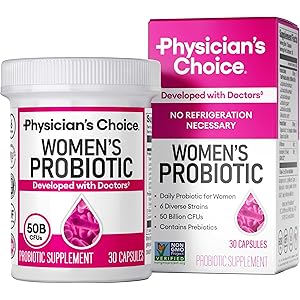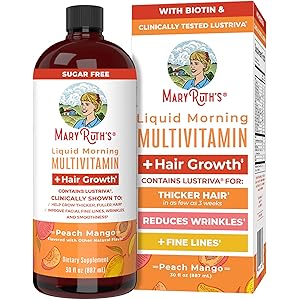Physician's CHOICE Probiotics for Women - PH Balance, Digestive, UT, & Feminine Health - 50 Billion CFU - 6 Unique Strains for Her - Organic Prebiotics, Cranberry Extract+ - Women Probiotic - 30 CT
$23.97 (as of May 19, 2025 11:59 GMT +00:00 - More infoProduct prices and availability are accurate as of the date/time indicated and are subject to change. Any price and availability information displayed on [relevant Amazon Site(s), as applicable] at the time of purchase will apply to the purchase of this product.)Where is Dietary Fiber Found in Fruits?
Dietary fiber is abundant in a variety of fruits, making them an excellent choice for those looking to increase their fiber intake. Fruits such as apples, bananas, berries, and pears are particularly high in fiber. For instance, an apple with its skin contains about 4 grams of fiber, while a medium banana offers around 3 grams. Berries, like raspberries and blackberries, are fiber powerhouses, providing around 8 grams per cup. These fruits not only contribute to your daily fiber needs but also offer essential vitamins and antioxidants, promoting overall health.
Where is Dietary Fiber Found in Vegetables?
Vegetables are another rich source of dietary fiber, with many varieties offering significant amounts per serving. Leafy greens such as spinach and kale, as well as cruciferous vegetables like broccoli and Brussels sprouts, are excellent choices. For example, one cup of cooked broccoli contains about 5 grams of fiber, while a cup of cooked Brussels sprouts provides around 4 grams. Incorporating a diverse range of vegetables into your meals can help you meet your fiber goals while also delivering vital nutrients that support bodily functions.
Where is Dietary Fiber Found in Whole Grains?
Whole grains are a fantastic source of dietary fiber, often containing more fiber than their refined counterparts. Foods like brown rice, quinoa, barley, and whole wheat bread are packed with fiber. For instance, one cup of cooked quinoa contains approximately 5 grams of fiber, while a slice of whole grain bread can provide around 2 grams. Choosing whole grains over refined grains not only boosts your fiber intake but also enhances your diet with additional nutrients, such as B vitamins and minerals, that are often lost during processing.
Where is Dietary Fiber Found in Legumes?
Legumes, including beans, lentils, and chickpeas, are some of the richest sources of dietary fiber available. A single cup of cooked lentils can contain up to 15 grams of fiber, making them an incredibly effective way to increase your daily intake. Black beans and kidney beans also offer substantial fiber content, with around 13 grams per cup. Incorporating legumes into your diet can provide not only fiber but also protein and essential nutrients, making them a staple for those seeking a balanced diet.
Where is Dietary Fiber Found in Nuts and Seeds?
Nuts and seeds are not only healthy fats but also a great source of dietary fiber. Almonds, chia seeds, and flaxseeds are particularly high in fiber. For example, a quarter-cup of almonds contains about 4 grams of fiber, while just two tablespoons of chia seeds can provide around 5 grams. Including a variety of nuts and seeds in your diet can enhance your fiber intake while also offering heart-healthy fats, protein, and a range of vitamins and minerals that contribute to overall wellness.
Where is Dietary Fiber Found in Snacks?
Many snacks can be surprisingly high in dietary fiber, especially those made from whole ingredients. Snack bars made with oats, nuts, and dried fruits can provide a convenient source of fiber. For instance, a fiber-rich granola bar can contain anywhere from 3 to 7 grams of fiber per serving. Additionally, popcorn, when prepared without excessive butter or salt, can be a low-calorie snack that offers about 3 grams of fiber per three-cup serving. Choosing fiber-rich snacks can help you stay full longer and support digestive health.
Where is Dietary Fiber Found in Breakfast Foods?
Breakfast foods can also be excellent sources of dietary fiber. Oatmeal, whole grain cereals, and high-fiber breads are great options to start your day. A cup of cooked oatmeal can provide around 4 grams of fiber, while many whole grain cereals offer 5 grams or more per serving. Adding fruits like berries or bananas to your breakfast can further boost fiber content, making your morning meal not only satisfying but also beneficial for your digestive system.
Where is Dietary Fiber Found in Dairy Alternatives?
For those who are lactose intolerant or prefer plant-based diets, many dairy alternatives are fortified with dietary fiber. Products like almond milk, soy milk, and oat milk can contain added fiber, enhancing their nutritional profile. For instance, some brands of oat milk can provide up to 2 grams of fiber per cup. Additionally, yogurt alternatives made from coconut or soy can also be enriched with fiber, making them a delicious and nutritious option for breakfast or snacks.
Where is Dietary Fiber Found in Processed Foods?
While many processed foods are low in fiber, there are some that are specifically designed to be high in dietary fiber. Products such as high-fiber bread, pasta, and snacks can help individuals meet their fiber needs conveniently. For example, some brands of high-fiber pasta can contain up to 6 grams of fiber per serving. However, it is essential to read labels and choose products that use whole ingredients and avoid excessive sugars and unhealthy fats to ensure you are making a healthy choice.


